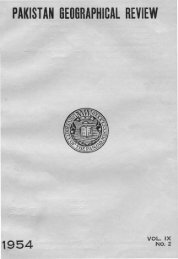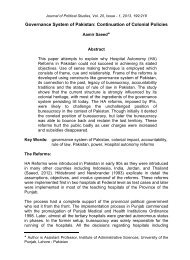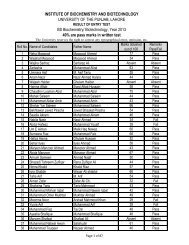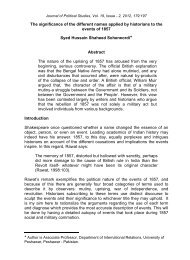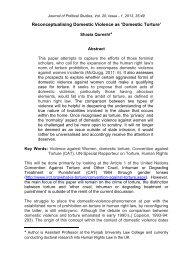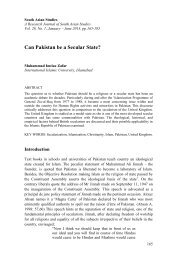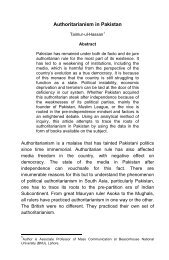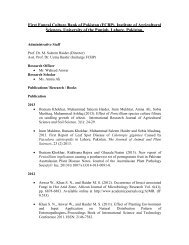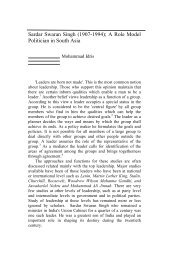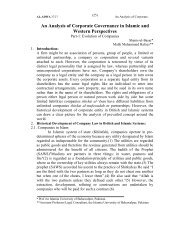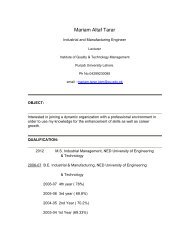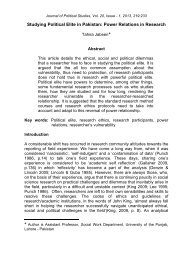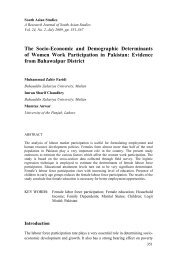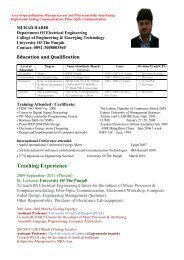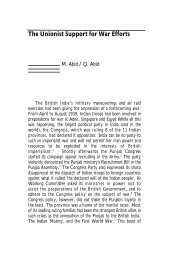4. Dr. Amir M. Haji Yousefi_January-June 2012
4. Dr. Amir M. Haji Yousefi_January-June 2012
4. Dr. Amir M. Haji Yousefi_January-June 2012
Create successful ePaper yourself
Turn your PDF publications into a flip-book with our unique Google optimized e-Paper software.
South Asian Studies 27 (1)<br />
Afghanistan is to develop the economic reconstruction in which the neighbouring<br />
countries, especially Iran, play an important role.<br />
Conclusion<br />
Despite of the common interests of the U.S. and Iran in overthrowing Taliban in<br />
2001, they are in loggerhead again there. The U.S. lack of acknowledging Iran’s<br />
cooperative role in Afghanistan made Tehran to choose a “no winner policy”<br />
whose aim is that neither the U.S. and NATO nor the Taliban forces win the battle<br />
in Afghanistan. Iran’s declared policy in Afghanistan is based on the regional<br />
solution for the Afghan chaos and non-tolerance of great powers` presence there.<br />
Therefore, this article concludes that Afghanistan can not be used as a bridge to<br />
establish a cooperative relationship between Iran and the U.S. The presence of the<br />
U.S. in Afghanistan is considered a major threat for Iran and thus the U.S. exit<br />
from Afghanistan not only eliminate this threat but also bring about a sort of<br />
freeing Iran’s capacities to run through its eastern borders (Tahaei, 2010).<br />
References<br />
Boroojerdi, A. (2009), “Manafe-e Moshtaraki ba Amrica dar Afghanistan Nadarim” (in<br />
Persian) (We have no Common Interest with the U.S. in Afghanistan), Vatan-e<br />
Emrooz, April 28.<br />
Daheshyar, H. (2009), “Amrica, Afghanestan va Pakestan: Se Zele naahamkhan-e yek<br />
Bohran” (in Persian) (The United States, Afghanistan, and Pakistan: Three<br />
nonadjustable sides of a Crisis), Ettelaat-e Siyasi va Eqtesaadi, Nos. 162-63<br />
Daheshyar, H. (2008), “Amrica va Paradigme Qoumi dar Afghanestan” (in Persian) (The<br />
United States and Ethnic Paradigm in Afghanistan), Ettelaat-e Siyasi va Eqtesadi, Nos.<br />
257-8<br />
Dehghani, J. (2009), The Foreign Policy of the Islamic Republic of Iran (Tehran: Samt)<br />
Dorraj, M and H. Zangeneh (2009), “Missed Opportunities and Political Blunders: The Tale<br />
of US-Iran Relations”, in Robert Looney (ed.), Handbook of US-Middle East Relations<br />
(London: Routledge)<br />
Ghafoori, Q. (2009), “Aakharin Senarioye Amrica dar Afghanestan” (in Persian) (The Last<br />
American Scenario in Afghanistan), Siyasat-e Rooz Newspaper, April 22.<br />
<strong>Haji</strong>-<strong>Yousefi</strong>, A. (2005), Siyasate Khareji-e Iran dar Partove Tahavvolat-e Mantaqaee (in<br />
Persian) (The Foreign Policy of the Islamic Republic of Iran in the Regional Context)<br />
(Tehran: IPIS)<br />
Halliday, F. (2001), “Tehran Mitavanad Naqshe Bishtar Ifa Konad” (translated to Persian)<br />
(Tehran can play more Role), Iran Newspaper, November 9.<br />
Jomhoori-e Eslami (1999), “6+2: Harekat dar Bonbast” (in Persian) (6+2: A Move in Deadend),<br />
July 19.<br />
Iran`s Ministry of Foreign Affairs (2008), Iran and Reconstruction of Afghanistan: 2001-<br />
2008.<br />
Iran: Afghanistan is Barometer of U.S. Relationship (2009), Oxford Analytical Daily Briefs<br />
Service, May 5.<br />
Khani, Ali A. (2005), Forsatha, Tahdidat va Chaleshhay-e fararooy-e amniyat-e melli-e Iran<br />
(in Persian) (Opportunities, Threats and Challenges Facing Iran`s National Security)<br />
(Tehran: Abrar Moaser)<br />
74



